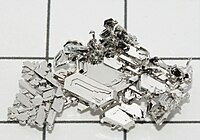
Photo from wikipedia
Two square-planar palladium(II) and platinum(II) azido complexes [M(N3)(L)] with L = N-phenyl-2-[1-(2-pyridinyl)ethylidene]hydrazine carbothioamide reacted with four different electron-poor alkynes R-C≡C-R' with R = R' = COOCH3, COOEt, COOCH2CH2OCH3 or R… Click to show full abstract
Two square-planar palladium(II) and platinum(II) azido complexes [M(N3)(L)] with L = N-phenyl-2-[1-(2-pyridinyl)ethylidene]hydrazine carbothioamide reacted with four different electron-poor alkynes R-C≡C-R' with R = R' = COOCH3, COOEt, COOCH2CH2OCH3 or R = CF3, R' = COOEt in a [3 + 2] cycloaddition "iClick" reaction. The resulting triazolate complexes [M(triazolateR,R')(L)] were isolated by simple precipitation and/or washing in high purity and good yield. Six out of the eight new compounds feature the triazolate ligand coordinated to the metal center via the N2 nitrogen atom, but fortuitous solubility properties allowed isolation of the N1 isomer in two cases from acetone. When the solvent was changed to DMSO, the N1 → N2 isomerization could be studied by NMR spectroscopy and took several days to complete. 19F NMR studies of the iClick reaction with F3C-C≡C-COOEt led to identification of a putative early linear intermediate in addition to the N1 and N2 isomers, however with the latter as the final product. Rate constants determined by 1H or 19F NMR spectroscopy increased in the order Pd > Pt and CF3/COOEt > COOR/COOR with R = CH3, Et, CH2CH2OCH3. The second-order rate constant k2 > 3.7 M-1 s-1 determined for the reaction of [Pd(N3)(L)] with F3C-C≡C-COOEt is the fastest observed for an iClick reaction so far and compares favorably with that of the most evolved strained alkynes reported for the SPAAC (strain-promoted azide-alkyne cycloaddition) to date. Selected title compounds were evaluated for their anticancer activity on the GaMG human glioblastoma brain cancer cell line and gave EC50 values in the low micromolar range (2-16 μM). The potency of the Pd(II) complexes increased with the chain length of the substituents in the 4- and 5-positions of the triazolate ligand.
Journal Title: Inorganic chemistry
Year Published: 2019
Link to full text (if available)
Share on Social Media: Sign Up to like & get
recommendations!